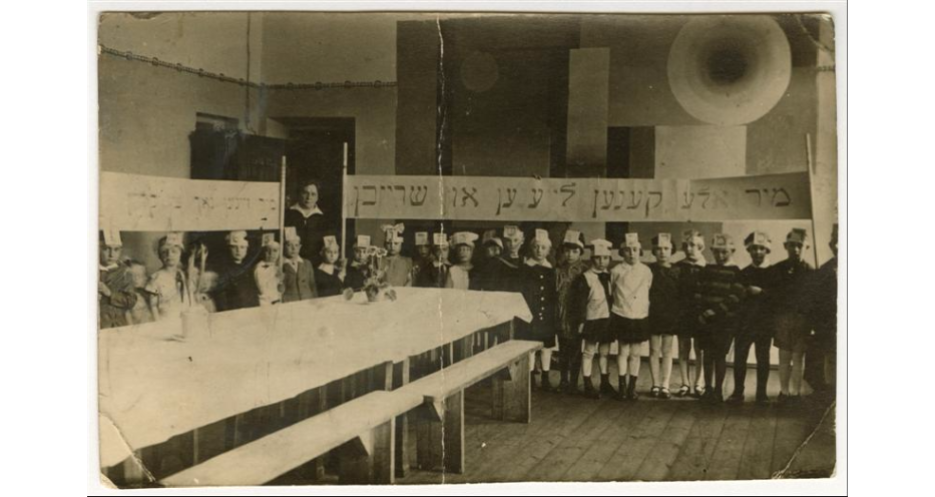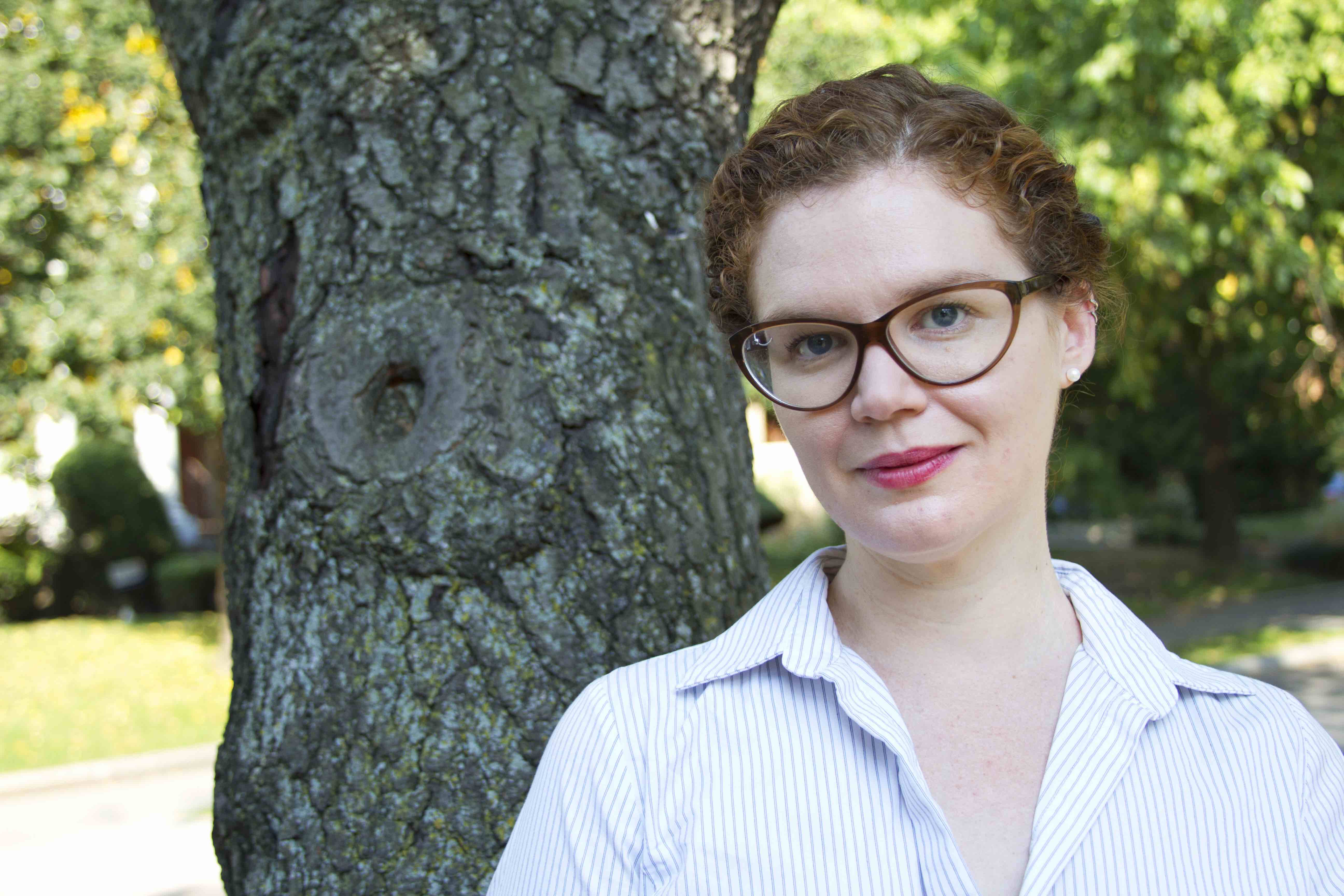Aug 23, 2016

Stefania Shifra Szabad, wife of Jewish communal leader Tsemaḥ Szabad, with a class in a Yiddish school, Vilna, 1929. Children, wearing hats representing letters of the alefbeys (alphabet), hold a banner (right) that reads in Yiddish: “We can all read and write.” (YIVO)
INTRODUCTION
In an effort to pool the wisdom and questions acquired from our contributors’ work in the classroom, In geveb regularly polls Yiddish language instructors on topics related to Yiddish pedagogy. The responses to these polls offer a cross-section of the opinions, approaches, and experiences of Yiddish language instructors from Los Angeles to Tel Aviv, from children’s programs to university classes to continuing education courses, from new teachers to those with a lifetime of experience. If you teach Yiddish language, add your voice to the discussion in our next poll. And if you want to share your opinion on the topic presented below, please do so! We may publish an addendum with new responses.
The first day of class: a time for excitement and anxiety among students. But for teachers . . . it can also be a time of excitement and anxiety. Whether you’re a newbie teacher or a seasoned veteran, the first day of class matters. A lot. We asked Yiddish teachers—in universities and cultural organizations—what they do to help students get acquainted with each other, with the teacher, and with the goals of the class. Here’s what we found:
Diving in
A number of the respondents have their students dive into listening and speaking from the very first day. Josh Price, at Columbia, wrote “I start with a baptism, lehavdl, by fire - straight into conversation with purely oral prompts, and gradually building to having each student present some basic facts about a fellow student: name, where they’re from, where they live, how they’re feeling that day, their major, which languages they know, etc.”
Jenna Ingalls, at the University of California at Berkeley, uses a similar approach: “On the first day of class I like to do a pretty standard communicative opening—a cold open, if you will. Students learn through varied repetition (conversation with instructor, and with other students one-on-one, and in groups) to greet one another, ask and give names, and where they are from. We essentially do: ‘Sholem aleykhem!’ ‘Aleykhem sholem!’ ‘Vi heystu? ‘Fun vanen kumt a yid?’ etc.” Jessica Kirzane, in her classes at Columbia University, leads a similar exercise and has students introduce teddy bears to the rest of the class if there aren’t enough students for partner work. She also recommends giving some options for answers: “gut, nishkoshe, got tsu danken, vos zol zikh hern?.”
Two professors, Brukhe Lang Caplan and Miriam Isaacs, take this Yiddish-only approach one step further, having students perform physical exercises while hearing Yiddish. Caplan, of Johns Hopkins University, uses a technique called Total Physical Response (TPR), giving commands in Yiddish for students to follow (shtelt zikh uf, geyt, loyft, shpringt, tantst, leyent, shraybt, zetst zikh avek). She wrote “I like to demonstrate to students at the very beginning that they can follow a lesson entirely in Yiddish, even though they are only just beginning to learn the language.” She added that the TPR commands come back in future lessons, so students will already know several verbs.
Isaacs (University of Maryland), noting that “it is easier to learn when you are not stuck in a chair,” has students take a walk outside, after teaching the phrase “vos iz dos,” “dos iz,” and the word “shpatsir.” The class walks around together, and students are only allowed to ask “Vos iz dos?” and then repeat the words Isaacs teaches. She wrote that students loved the activity, and that “their friends passing by asked what the language was and they could right away take pride in doing something different.”
But what about the syllabus?
Obviously, students will need, and want, a sense of where the class is going, what’s expected of them, and what kind of homework they’ll have.
All of the teachers we surveyed take some time (between ten and twenty minutes) to go over the syllabus, in English. But most of them did this only after the Yiddish introductions, thus giving the students a taste of the class before the nuts-and-bolts, “housekeeping” activities. Some teachers incorporated spoken Yiddish into this part of the class as well. Jessica Kirzane reads the following three times:
דאָס איז ייִדיש פֿאַר אָנהייבערס. דער קלאַס טרעפֿט זיך דינסטיק, דאָנערשטיק, און פֿרײַטיק. אונדזער בוך הייסט ייִדיש אַן אַרײַנפֿיר: לשון, ליטעראַטור, און קולטור. מען קען עס קויפֿן אין ״בוק קולטשור״. דאָ אין קלאַס וועלן מיר זיך לערנען צו רעדן, צוהערן, לייענען, און שרײַבן.
This is Yiddish for beginners. The class meets Tuesday, Thursday, and Friday. Our book is called Yiddish: An Introduction to the Language, Literature, & Culture. You can buy it at Book Culture [a bookstore near Columbia]. Here in class, we’ll learn to speak, listen, read, and write.
After reading the lines, she has the students answer “yo oder neyn” (True or False) questions to see if they have understood (for example: “Dos iz avansirt yidish. Yo oder neyn?”).
What is Yiddish?, and Yiddish Basics
A few teachers also give some of the history of Yiddish, its varieties, and some of the contexts in which it is spoken. Some professors lecture for this section, while others, like Jessica Kirzane, see it as an opportunity for a trivia game. Most teachers, time permitting, try to introduce the alphabet on day one, whether letter by letter or divided into consonants/vowels.
Brukhe Lang Caplan also teaches numbers 1-10 and some simple geography. After writing numbers 1-10 on sticky notes, she asks students to come up to the front of the room and put a number on a particular place. She uses language like this:
שׂרה, קלעפּט אויף נומער 1 אויף אייראָפּע. אייראָפּע איז אַ קאָנטינענט.
לייבל, קלעפּט אויף נומער 2 אויף ענגלאַנד. ענגלאַנד איז אַ לאַנד.
איז ענגלאַנד אַ לאַנד אָדער אַ קאָנטינענט? איז אייראָפּע אַ לאַנד אָדער אַ קאָנטינענט?
פּערל, קלעפּט אויף נומער 3 אויף קאַנאַדע.
איז קאַנאַדע אַ לאַנד אָדער אַ קאָנטינענט? … איז קאַנאַדע אַ לאַנד אין אייראָפּע? ניין, קאַנאַדע איז אַ לאַנד אין אַמעריקע, אין צפֿון־אַמעריקע.
וואָס איז נומער 1? אַ לאַנד אָדער אַ קאָנטינענט?
איז ענגלאַנד נומער 1? 2? 3?
Sore, put number 1 on Europe. Europe is a continent.
Leybl, put number 2 on England. England is a country.
Is England a country or a continent? Is Europe a country or a continent?
Perl, put number 3 on Canada.
Is Canada a country or a continent? Is Canada a country in Europe? No, Canada is a country in America, in North America.
What is number 1? A country or a continent?
Is England number 1? 2? 3?
She adds, “Continuing in the same vein, I teach the words kontinent, land, shtot/hoyptshtot, shtat, [and] shprakh and usually also tsofn, dorem, mizrekh, [and] mayrev.” This leads to a discussion of where students are from. A few classes later, Caplan has students read the first text in College Yiddish, and asks them to update it for a current textbook. (See our previous forum on using College Yiddish.)
To sum up: all of our lerers agreed that a small amount of Yiddish immersion on day one is important, even with absolute beginners. Respondents also agree that relevance to everyday life, whether it’s introducing yourself or pointing out everyday objects, is important too. Vos nokh? Josh Price added one final element, one that might entice students “shopping” for classes to come back: after singing ‘Rozhinkes mit mandlen,” providing the class with actual raisins and almonds as a snack.
***
What do you do on the first day of class? We hope you’ll share a lesson plan or activity you’ve designed! And, you can participate in our next poll, on using Yiddish in translation.



